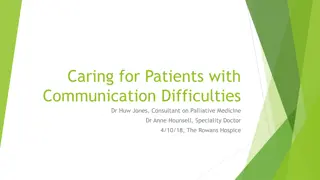Understanding Neurogenic Speech and Language Disorders in Adults
This chapter provides insight into language disorders in adults, including types of aphasia, causes such as toxins, traumatic brain injury, brain tumors, and strokes. It discusses cerebral hemorrhage, occlusive strokes, ischemic stroke, transient ischemic attacks, and cerebral thrombosis. The conten
1 views • 34 slides
Anatomy of the Larynx, Trachea, and Bronchi: Respiratory System Overview
The larynx, trachea, and bronchi are vital structures of the respiratory system with distinct functions and anatomy. The larynx houses vocal cords, aids in breathing, voice production, and swallowing. It is interconnected with major arteries, veins, and nerves in the neck. The trachea extends from t
12 views • 19 slides
Autism - What is it and how can you support an autistic person?
Autism Spectrum Disorder (ASD) is assessed using DSM-5 criteria, focusing on impairments in emotional reciprocity, relationships, and communication. Individuals may also display difficulties in movements, routines, interests, and sensory needs. Beyond ASD, considerations include ADHD, anxiety disord
3 views • 24 slides
Understanding Vulnerabilities of Individuals with Autism in Disciplinary Hearings and Employment Tribunals
People with autism may face vulnerabilities in disciplinary proceedings and employment tribunals due to impaired theory of mind, communication difficulties, insistence on sameness, stereotyped behaviors, and sensory sensitivities. These challenges can lead to misunderstandings, difficulties in copin
0 views • 10 slides
Understanding Communication Challenges in Adults with Learning Disabilities
Explore the complexities of communication difficulties faced by adults with learning disabilities, affecting up to 90% of this population. Understand the individualized communication needs based on varying factors like co-occurring diagnoses and existing support systems. Delve into the risks posed b
2 views • 12 slides
Overview of Digestive System Physiology and Functions
The digestive system functions to break down food into absorbable forms through processes like ingestion, propulsion, digestion, absorption, and elimination. Specific organs and enzymes play key roles in these processes, ultimately providing nutrients for the synthesis of body constituents and energ
0 views • 13 slides
Understanding Thickened Liquids in Dysphagia Management
Thickened liquids are often recommended for residents with swallowing difficulties to prevent aspiration pneumonia. Recommendations are typically made by speech pathologists, with nursing sometimes adjusting based on availability of therapy. Aspiration pneumonia occurs when substances are inhaled in
2 views • 33 slides
Understanding the Physiology of the Sensory Organ - Tongue by B.K. Singh
Taste perception on the tongue is a vital sensory function involving sweet, sour, salty, and bitter sensations. The tongue, with its muscular movements and taste buds, plays a crucial role in mastication, swallowing, and food enjoyment. Different types of papillae on the tongue are responsible for t
4 views • 33 slides
Understanding Pharyngitis: Causes, Symptoms, and Management
Pharyngitis is an inflammation of the pharynx characterized by coughing, painful swallowing, and appetite changes. It can be caused by physical or infectious factors, leading to symptoms such as virtual obstruction, regurgitation, and drooling. Understanding the etiology and pathogenesis is crucial
1 views • 32 slides
Understanding Dosage Forms and Excipients in Medication Design
Dosage forms play a crucial role in the safe delivery and effectiveness of medications. They serve various purposes such as protecting drugs from environmental factors, controlling drug release, and providing different routes of administration. Excipients like flavors, colorants, and preservatives a
0 views • 27 slides
Specialist Teacher Training Course in Maths Difficulties and Dyscalculia
Enroll in our Level 5 online course led by experts Judy Hornigold and Prof. Steve Chinn to learn to identify, assess, and support learners with maths difficulties and dyscalculia. Gain practical skills, access recorded sessions, receive tutor support, and benefit from guest speakers and interactive
0 views • 24 slides
Understanding Orofacial Development and Functions in Dentistry
Explore the intricate orofacial structures, including dental arches, naso-maxillary complex, mandible, and muscles of expression, mastication, and deglutition. Learn about the various functions performed by the orofacial complex, such as mastication, deglutition, respiration, and speech. Dive into t
1 views • 23 slides
Understanding Gastric Motility and Secretion in the Stomach
The stomach plays a crucial role in food processing, acting as a reservoir, preparing chyme for digestion, and facilitating absorption. Divided anatomically and physiologically, it functions as a storage unit and mixing chamber for food. Key motor functions include storage, preparation for digestion
0 views • 49 slides
Understanding Documentation and Regulatory Standards in SLP Practice
Learn about regulatory standards for documenting speech-language pathology (SLP) services, including Medicare regulations and evidence-based practices. This course provides practical case studies for applying learned material, covering topics such as skilled care, complex documentation, and hands-on
0 views • 83 slides
Speech Therapy Guidelines and Medicare Regulations Overview
This content provides detailed information on writing person-centered functional goals in speech therapy, emphasizing SMART goals and best practices. It covers course descriptions, objectives, and Medicare regulations related to speech therapy services. The importance of reasonable and necessary evi
0 views • 90 slides
Speech-Language Pathologist's Role in TBI Assessment & Treatment
Speech-language pathologists play a crucial role in assessing and treating traumatic brain injuries (TBI) which affect millions annually, with significant impact on children. SLPs collaborate with medical specialists, provide screenings, comprehensive evaluations, treatment development, and advocacy
0 views • 44 slides
Communicating with Patients with Cognitive Impairment and Other Communication Difficulties
This presentation highlights the causes of communication difficulties in patients, focusing on cognitive impairment, sensory impairments, and language barriers. It emphasizes the challenges of caring for these patients, including assessing pain and managing symptoms effectively. Practical strategies
0 views • 27 slides
Understanding Dysphagia in the ICU: Assessment and Impact
Dysphagia, the difficulty in swallowing, is a common issue in the ICU, affecting a significant percentage of intubated patients. It increases mortality, risk of pneumonia, malnutrition, and prolongs hospital stays. Assessment methods like bedside evaluation and FEES are crucial in managing dysphagia
5 views • 8 slides
Understanding Lego Therapy for Children with Social Communication Difficulties
Lego therapy is a social development program for children with autism spectrum disorder or social communication difficulties. It involves using Lego bricks and role-playing to enhance skills like sharing, turn-taking, following rules, and problem-solving. Children benefit from improved communication
0 views • 8 slides
Understanding Achalasia: Therapeutic Approaches, Pathophysiology, and Clinical Manifestations
Achalasia is characterized by a failure of the lower esophageal sphincter to relax, leading to difficulty in swallowing and regurgitation. The exact cause is unknown, but autoimmune factors and chronic infections may play a role. Symptoms include dysphagia, chest pain, regurgitation, and weight loss
0 views • 59 slides
Interactive Tutorial on Degenerate Perturbation Theory: QuILT Development and Student Difficulties
Developing an interactive tutorial on Degenerate Perturbation Theory (DPT) to aid students in understanding the challenging synthesis of Quantum Mechanics concepts with Linear Algebra. The tutorial focuses on addressing common student difficulties, such as identifying good bases, diagonalizing matri
0 views • 12 slides
Analysis of Disability Statistics Guidelines and Indicators (80 characters)
Guidelines and indicators for analyzing disability statistics are presented, covering difficulties in vision, communication, hearing, cognition, mobility, lifting, and upper body functions. Data from various surveys provide insights into the prevalence and severity of disability challenges. The imag
0 views • 16 slides
Understanding Gastrointestinal Motility: Key Concepts and Mechanisms
Gastrointestinal motility involves various processes like peristalsis, segmentation, basic electrical activity, and the migrating motor complex. Peristalsis is the reflex response to gut wall stretching, while segmentation helps mix intestinal contents and digestive juices. Basic Electrical Rhythm (
0 views • 19 slides
Understanding Section K: Swallowing and Nutritional Status Assessment
Section K assesses conditions impacting residents' nutrition and hydration. It covers swallowing disorders, weight changes, and nutritional approaches. Proper coding and care planning are essential for accurate assessment. The section includes evaluation of swallowing difficulties, weight measuremen
0 views • 26 slides
Understanding Capsules in Pharmacy: Types, Advantages, and Disadvantages
Capsules in pharmaceuticals are solid unit dosage forms encasing precise amounts of medicines in gelatin shells. They come as hard or soft gelatin capsules, offering benefits like easy swallowing, taste masking, rapid release of medication, and cost-effectiveness. However, capsules have limitations
0 views • 84 slides
Managing Eating and Swallowing Challenges After Stroke
Dysphagia, a common issue after a stroke, can lead to difficulty swallowing and may require texture modifications in food and fluids for safety. Up to 65% of stroke survivors may experience dysphagia, which can lead to complications like pneumonia. Proper oral care, mealtime positioning, and awarene
0 views • 9 slides
New Perspectives on Professional Practice with Parents with Learning Difficulties Concerning Child Neglect
Exploring innovative approaches in working with parents with learning difficulties facing concerns of child neglect, this study sheds light on the challenges, support systems in place, concerns regarding child welfare, and relationships with social workers. The research highlights the need for tailo
0 views • 47 slides
Comprehensive Overview of Head and Neck Cancer by Dr. Swati Lambor, ENT Consultant
Cancer of the head and neck region poses a significant threat, with various types of tumors affecting areas like the nasal cavity, paranasal sinuses, mouth, larynx, salivary glands, and thyroid. Dr. Swati Lambor, a skilled ENT consultant at Manipal Hospital in Goa, sheds light on the causes, progres
0 views • 72 slides
Anatomy of the Pharynx: Structure and Function
The pharynx is a musculomembranous tube that connects the nasal and oral cavities to the larynx and esophagus. It is divided into three parts: nasopharynx, oropharynx, and laryngopharynx, each with unique features and functions. Muscles like pharyngeal constrictors and palatopharyngeus play a crucia
0 views • 31 slides
Preventing Complications in Newborns: Tips and Strategies
Learn effective ways to prevent common complications in newborns, such as hypothermia, infection, and breathing difficulties. Discover practical tips for maintaining the baby's health and well-being during the crucial early stages, including measures to prevent hypothermia, infection, and breathing
0 views • 6 slides
Paradigm Change in Addressing Children's Literacy Difficulties
Professor Vivian Hill advocates for a paradigm change in understanding, assessing, and intervening in children's literacy difficulties at the AEP Conference. Challenges in the field are discussed, including the need to move towards inclusive, universal responses for all children with literacy delays
0 views • 28 slides
Understanding Thickened Fluids in Aged Care Facilities
Exploring the adequacy of thickened fluids in residential aged care settings, a study examined staff perceptions, preparation factors, adherence to IDDSI standards, and issues related to dysphagia. Findings revealed barriers, enablers, and the importance of staff education and support in ensuring th
0 views • 7 slides
Understanding Myasthenia Gravis: Symptoms, Causes, and Treatment
Myasthenia gravis is a condition characterized by muscle weakness and rapid fatigue due to communication issues between nerves and muscles. While there is no cure, treatment options are available to manage symptoms such as weakness, double vision, and difficulties with speech and swallowing. Factors
0 views • 21 slides
Understanding Dementia and Speech Therapy by Vincent Delgiudice
Dementia impacts speech, swallowing abilities, and quality of life. Vincent Delgiudice, a certified SLP, offers therapy to enhance memory, communication, and safe swallowing strategies. Dysphagia in dementia needs evaluation for proper treatment. Learn about types of dementia symptoms and different
0 views • 19 slides
Analysis of Character Development in "Swallowing Stones Journal
In "Swallowing Stones Journal," we explore the character development of Michael and Jenna through various chapters. Michael's transformation from a carefree individual to someone haunted by guilt is contrasted with Jenna's coping mechanisms and growth. The narrative delves into themes of responsibil
0 views • 13 slides
Investigating Physics Students' Difficulties with Basic Math Skills
Physics instructors face challenges in assessing students' mathematical skills, particularly in trigonometry, graphing, vectors, and algebra. A study at Arizona State University analyzed 2700 students across 21 physics classes and conducted interviews to uncover prevalent difficulties. Results showe
0 views • 25 slides
Understanding Mental Health Difficulties in Students
Mental health problems can affect students' academic performance, social relationships, and overall well-being. This article explores the factors that impact students' mental health, signs to spot deteriorating mental health, and ways to support students dealing with such difficulties.
0 views • 15 slides
Review of Dysphagia Care for Parkinson's Patients in Hospital
A review was conducted on the quality of dysphagia care provided to patients with Parkinson's disease aged over 16 years who were admitted to the hospital when acutely unwell. Key findings include the importance of documenting swallow status in referral letters, screening patients for swallowing dif
0 views • 24 slides
Essential Monitoring and Care for Gastrointestinal Patients
Learn about monitoring and caring for gastrointestinal patients, including identifying key symptoms like appetite changes, taste alterations, swallowing difficulties, gastric dyspepsia, and more. Discover how to provide proper nursing care, address acute abdominal pain and gastrointestinal bleeding,
0 views • 28 slides
Universal Light-Touch Screener for Early Identification of Children's Learning Difficulties
Proposal framework advocating for teacher-led implementation of a universal light-touch screener to identify children's learning difficulties early. Emphasis on timely intervention, equitable access to support, and improving outcomes for all children. Recommendations include broadening assessment cr
0 views • 11 slides







































